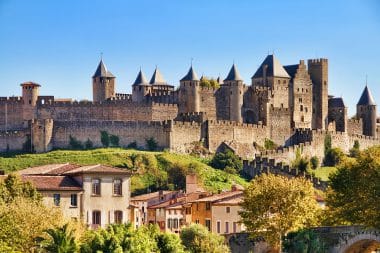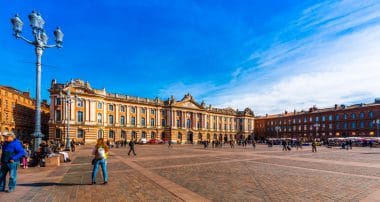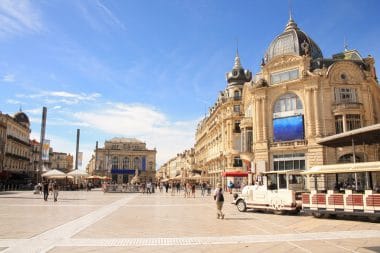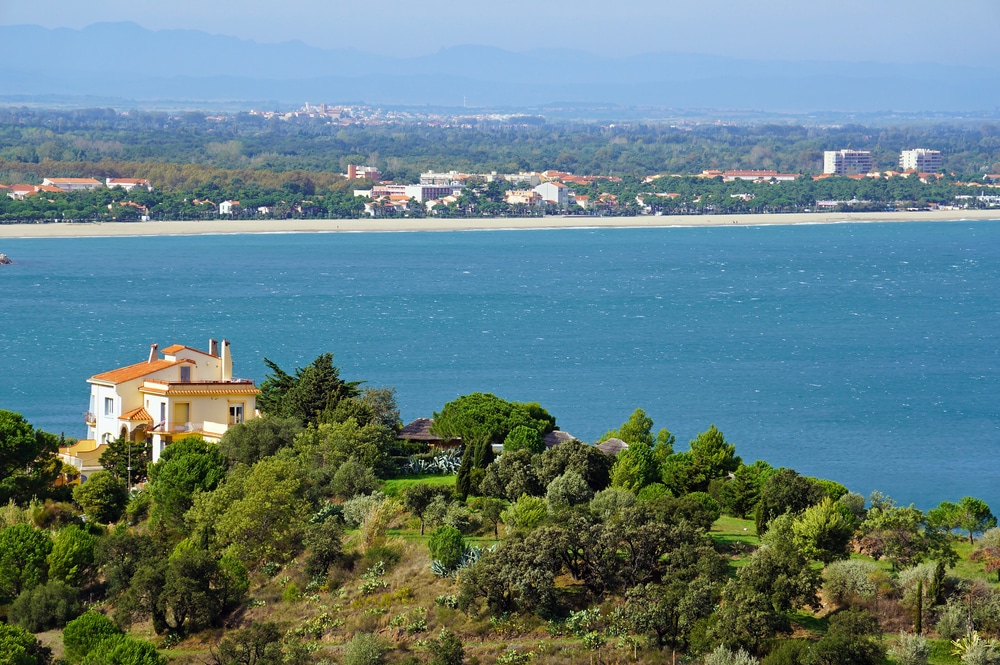Similar and analogous to the “white sausage equator” that is still common in Germany today, approximately along the Main line or the 49th parallel, Occitania also exists in France , a culturally and linguistically defined border between north and south. In the neighbouring country, it is the 45th parallel that separates the historically strongly Romanesque south (“Le Midi”) including the regions of Provence-Alpes-Côte d’Azur, Occitanie and Nouvelle-Aquitaine as well as Auvergne-Rhône-Alpes from the more traditionally Celtic-influenced north.

In particular, the administrative region of Occitania, which was newly formed in 2016 from Languedoc-Roussillon and Midi-Pyrénées and covers almost 73,000 km² and currently has almost 5.7 million inhabitants in currently 13 départements, can look back on a long and eventful history as an important cultural landscape. Today’s Occitania, around the largest cities of Toulouse, Montpellier, Nîmes and Perpignan as well as Béziers, Montauban, Narbonne, Albi, Carcassonne and Sète, is smaller than the historical region defined by the Occitan language, which also includes Limoges, Bordeaux, Marseille and Nice .
Today, the regional population is once again defining itself more culturally
Although Occitania never represented a separate state, Occitan as a Gallo-Roman language closely related to Catalan was widely spoken throughout southern France from the 8th to the 14th century. Occitan was used a lot, especially as a language of poetry and literature.

It was not until the Albigensian Crusade from 1209 to 1229 against the Cathar religious community in the region, which the Vatican denigrated as heretical, that this heyday of the language ended. Today, the minority language, which is partially recognized by the French state, has about two million native speakers. In recent years, the regional and traditional awareness in Occitanie has increased significantly again.
Well-attended demonstrations for full recognition as an official and school language, as well as events and publications by the “Institut d’Estudis Occitans”, the “Partit Occitan” party in Toulouse and the association “Per Noste” (For Us) in Orthez (arrondissement of Pau in the Pyrénées-Atlantiques) are attracting great interest. Today, bilingual town and street signs can often be seen in the region, on which the Occitan names are usually depicted in the traditional colours of gold and red of the Occitan coat of arms.
The Mediterranean is an ever-present economic factor in Occitanie
As a very charming travel destination, because it is both scenically and culturally diverse and climatically reliably warm almost all year round, Occitanie has been internationally known and popular since the early 20th century at the latest. The well-established seaside resorts on the Mediterranean coast in the departments of Gard, Hérault, Aude and Pyrénées-Orientales such as Frontignan, Sète, Agde, Saint-Laurent-de-la-Salanque, Canet-en-Rousillon as well as Saint-Cyprien and Argelès-sur-Mer are particularly popular.
Typical of the Occitan coast are also the numerous étangs or lagoons that line up like a string of pearls between Montpellier in the east and Perpignan in the southwest. The Étang de Charnier, Étang de Scamandre, Étang de L’Or, Étang de Vic, Étang de Thau, Étang de Bages, Étang de l’Ayrolle, Étang de la Palme and Étang de Leucate are increasingly used for boating and water sports in addition to fishing, oyster farming and salt production. Another recommended destination for excursions is the 80,000-hectare nature park “Narbonnaise en Méditerranée” in the Aude department, which serves as a habitat for numerous species of waterfowl.
Nature and culture are often only a few kilometres apart
Nature and hiking enthusiasts with a desire for fantastic panoramas are also recommended to visit the other regional nature parks Causses du Quercy (Lot), Grands Causses (Aveyron), Haut-Languedoc (Hérault, Tarn) as well as Pyrénées Ariégeoises (Ariège) and Pyrénées Catalanes (Pyrénées-Orientales).

No less popular, especially among culturally interested travelers, are the larger cities in the region, each of which has many historically significant and worth seeing architectural attractions as well as art treasures. In the Occitan capital Toulouse, the UNESCO World Heritage Sites of the “Canal du Midi” and the Basilica of St-Sernin from the 12th century are often visited.
Montpellier is known for its popular meeting place in the old town, the “Place de la Comédie” as well as the art museum “Musée Fabre” from 1828 and the impressive Antigone district. Nîmes has a well-preserved ancient amphitheatre and other buildings from the Roman era, as well as the “Jardins de la Fontaine” park, which is always popular in summer. Popular photo motifs in Perpignan are the Palace of the Kings of Mallorca from the 13th century and the local mountain “Pic du Canigou”.
Occitanie is ideal for extended excursions and round trips
Béziers has the magnificent and strolling mile “Allée Paul-Riquet” in the centre, the historic churches of Saint Aphrodise, Saint-Jacques and de la Madeleine as well as the lock staircase “Fonserannes” on the Canal Midi from the 18th century. Montauban is idyllically located on the Tarn River, which is crossed by old stone bridges, and has numerous historic brick buildings, such as around the medieval market square “Place Nationale”.
In Narbonne, you can admire the remains of the Roman trade route “Via Domitia” from Italy to Spain , as well as the Saint-Just Cathedral from 1272 and the “Canal de la Robine”. In Albi, the UNESCO World Heritage Site of the Bishop’s Quarter including the “Musée Toulouse-Lautrec d’Albi” in the “Palais de la Berbie” as well as the Sainte-Cécile Cathedral and the old bridge “Pont Vieux” are the most famous crowd pullers. The city of Carcassonne is located on the two rivers Aude and Fresquel as well as on the Canal du Midi and is popular because of its imposing city fortress “Cité de Carcassonne”, which is listed as a UNESCO World Heritage Site. Sète has the two museums “Paul Valery” for the history of the city and “Espace Georges Brassens” for the memory of the singer and poet of the same name, as well as the Mont Saint-Clair with a great view of the city and the neighboring lagoon Étang de Thau.
https://youtu.be/gDEtmoivJig
The multifaceted cuisine of Occitanie has something for every taste
The delicious cuisine of the region is made for so many possible walks through the cities and towns of Occitania. Fresh fish and seafood come daily from the nearby Mediterranean and Atlantic Oceans, as well as from the rivers of the area. Livestock graze on the lush pastures in the valleys of the interior.
In the pleasantly mild climate, typical ingredients such as herbs, garlic, tomatoes, olives, grapes, peppers and aubergines thrive excellently. Depending on the area, Occitan cuisine is strongly inspired and influenced by Catalan, Spanish and Italian cuisine. It is a regionally highly differentiated Mediterranean cuisine with some Atlantic aspects.
Frequent on the menus of inns are “bouillabaisse” (fish soup), “aioli” (garlic mayonnaise), “pan golçat” (garlic bread), “cassoulet” (stew of white beans, bacon, pork or lamb and sausages), “pâté aux pommes de terre” (potato pie), “aligot” (cream of cheese and potatoes), “freginat” (pork meat platter), “clafoutis” (casserole cake with fruit), “flaugnarde” (pancakes with fruit) and “garbure” (cabbage stew with meat).
Facts about Occitanie
Geography and population
- The region stretches from the Pyrenees in the south to the Massif Central in the north and from the Rhone in the east to the Atlantic coast in the west.
- The capital of the region is Toulouse, one of the largest cities in France. Other important cities are Montpellier, Nîmes, Perpignan and Carcassonne.
- Occitania has a population of approximately 5.9 million people.
Culture and language
- The name Occitanie comes from the Occitan language (Langue d’oc), which is traditionally spoken in this region, although French dominates today.
- The region is known for its rich culture and history, which is expressed in its numerous castles, cathedrals and medieval towns.
- Occitanie is also known for its culinary specialties, including cassoulet, foie gras and a variety of wines such as Corbières, Minervois and Cahors.
Economy
- The region’s economy is diverse, ranging from agriculture and viticulture to high-tech industries, especially in the aerospace industry in and around Toulouse.
- Occitanie is a major tourist hotspot in France. It is particularly known for its Mediterranean coast, its historical sites and natural attractions such as the Pyrenees and the Canal du Midi.
Education and research
- Occitanie is home to several prestigious universities and research institutions, including the University of Toulouse, the University of Montpellier and the Supaero (Aerospace College).
- The region is an important center for research and development in the fields of space, biotechnology, health sciences and renewable energies.


